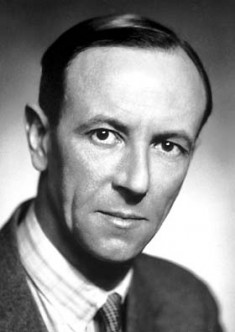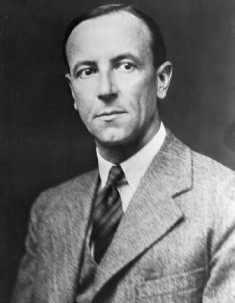| James Chadwick | |
|---|---|
 |
|
| Physicist | |
| Specialty | Nuclear physics |
| Born | Oct. 20, 1891 Bollington, Cheshire, England |
| Died | July 24, 1974 (at age 82) Cambridge, England |
| Nationality | English |
Sir James Chadwick was a famous English physicist. He was awarded the 1935 Nobel Prize in Physics for discovering the neutron in 1932. During the Second World War, he was the head of the British scientists that worked on the Manhattan Project. In 1945, he was knighted for his outstanding achievements in the field of physics.
Early Life and Education
James was born on October 20, 1891, in Bollington, Cheshire. He was the first child and was named after his grandfather. In 1895, his parents left and went to Manchester, leaving him to live with his grandparents. He joined a local primary school and was offered scholarship to Manchester Grammar School for Boys. This school was in Manchester and so he had to join his parents there. At the age of 16, he sat for the university scholarship exams and was lucky to be offered both.
Chadwick chose to join the Victoria University of Manchester in 1908. Like many other students, James had to walk a long distance each day from home to school. At the end of his first year in the university, he was awarded the Heginbottom scholarship to concentrate on studying physics. At the physics department, he was given an assignment of coming up with a way of comparing the amount of radioactive energy from two different sources. He graduated with first-class honors in 1911.
Working with Radiation
By this time, James Chadwick had already devised some ways of measuring gamma radiation. He proceeded to measure the absorption of different gamma rays by various liquids and gases. He later published his results. In 1912, he was awarded his masters degree and was even appointed a Beyer Fellow.
After one year, he was awarded an 1851 Exhibition Scholarship. This scholarship allowed him to research at a university in Europe. In 1913, he was chosen to go to Berlin to study beta radiation under Hans Geiger. With the help of Geiger, James was able to demonstrate how beta radiation produced continuous electromagnetic spectrum rather than some discrete lines as previously believed.
Chadwick during WWI

During WWI, James Chadwick was still in Berlin. He was interned in a camp near Berlin; here, he was allowed to set up his laboratory in stables. He conducted his experiments using some improvised materials like radioactive toothpaste. He also worked on ionization of phosphorous and photochemical reaction of chlorine and carbon monoxide. In 1918, he returned to his parent’s home in Manchester.
After WWI
In Manchester, he was offered a teaching position that allowed him to continue with his research. Here, he worked on the nuclear charge of silver, platinum, and copper. In 1919, he joined the University of Cambridge and the following year he was awarded the Clerk-Maxwell Studentship. In 1921, he was awarded his degree and he became a fellow of Gonville and Caius College.
Discovery of Neutron and More
In 1922, James Chadwick got a research position as Rutherford’s assistant. The two spent a lot of time working on alteration elements. They also tried to split up the nucleus of one element to form some other elements.
In 1932, James began experimenting with neutrons. His discovery was an important milestone in the understanding of nucleus. He was even awarded the Hughes Medal by Royal Society in 1932, the Coley Medal in 1930, and the Franklin Medal in 1951. His discovery of the neutron also made it possible to create elements heavier that uranium in the lab.
In 1935, James Chadwick was offered a position at University of Liverpool. When he accepted the position, he decided to set about acquiring a cyclotron for Liverpool. He began by spending some money to refurbish the laboratories at Liverpool. He was able to persuade the university to give him some money and was even able to get a grant of more money from Royal Society. He created his cyclotron and brought in two young experts.
By 1945, James was spending most of his time in Washington D.C. His family even relocated from Los Alamos to Washington D.C.
Later Life
Soon after the Second World War, James was appointed British scientific advisor to the United Nations Atomic Energy Commission. In 1946, he returned to Britain. In 1948, he became the Master of Gonville and Caius College. Over the years, he received many honors from different institutions. He died on July 24, 1974.